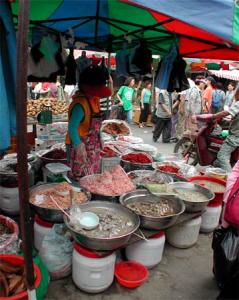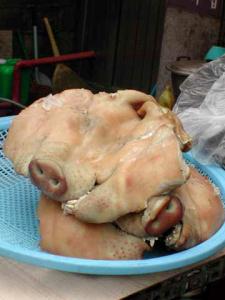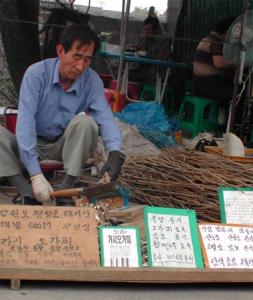
 Choices – local market
Choices – local market
I have always felt that visiting a supermarket in a new country is a good way to get an initial insight into its culture. Certain things such as yoghurts, washing powders and soft drinks may be much the same worldwide, but a stroll down the meat section in Korea can be different from the meat section in England or America. Pig’s heads and types of fish you have not seen before for example, become noticeable. In the fruit and vegetable section, you see types that are unfamiliar and a few vegetables not recognisable, but they are popular and part of the diet in Korea.
Koreans use Chinese medicine a lot. As a result, supermarkets often stack traditional remedies such as deer antlers, thought to give energy and strength. On first seeing them, I thought they looked unappetising, since they were cut into thin bloody slices, but they are common and expensive. I tried a medicine that contained deer antlers extract, ginseng and other herbs. Even though I didn't like the taste, I felt more energetic! Did the fact that I almost jumped out of my skin have something to do with the sudden burst of vitality? I get the same reaction from drinking a full bottle of Soju!

 Pig's head – local market
Pig's head – local market
A national treasure
Korean supermarkets offer a great selection of items such as tofu and kimchi. Tofu comes in many different types, usually varying according to the consistency. It tastes great in soups, especially in one of my favourite, Sun-Dubu. I prefer the soft tofu, but I like it cut into slices or diced and fried.
Korea's specialty, found everywhere, is kimchi. I will refer to it many times; it's unavoidable. It is like writing about England without mentioning football, pubs and London; or writing about America and not mentioning Bush or baseball; or writing about the French and not referring to how much they hate visitors speaking English rather than French in their country.
The importance of kimchi became clear as soon as I arrived in Korea. Not only did it come up in conversations in classes, but there are dozens of variations. My students told me that kimchi is more than a food; it is a necessity, a passion, an essential ingredient of Korean culture! Many of them miss it more than anything else when they go abroad. One student misses it more that his family and friends!

 A local chopping wood
A local chopping wood
After several months I learned there are over 100 different types of kimchi and different types according to the area of the country. Cheju island, for example, has Haemul (seafood) kimchi; Nabak (square cut radish); Kangwon Province has Chanran (fish paste and sliced radish) kimchi and Ojingeo Mu-u (squid radish) kimchi. Ch'ungch'ong Provinces have Gul Ggaktugi (oyster and sliced radishes) and Hobak (pumpkin) kimchi. You get the point.
I like kimchi; I never hesitated to eat it. My favourite is Myeolchi kimchi – made with a dried fish base, has a strong seafood taste. Many English teachers in South Korea like it too. I could not eat it for breakfast, though. People from Anglo countries dislike Myeolchi kimchi, but they like other types of kimchi. The fact that many Koreans eat kimchi at every meal, including breakfast, attests to the depth of their passion for their national treasure.
Ready-made Korean specialties such as Korean pancakes, cold glass noodles, cooked vegetables and sautéed mushrooms can also be found. A warning! Be careful of Korean bread; things are not always as they seem. What looks like a normal Western loaf of bread, leaves you with a mouthful of cream when you bite into it. The centre is often full of cream, nothing wrong with it, but it's surprising when you're not expecting it. It could be because Koreans usually eat rice at every meal; hence the bread is more like a dessert. Maybe it is something new – to keep Westerners on their toes!
For an Englishman, the tea section in a supermarket is important. Green tea and barley tea are common; quality is always good. The problem, though, is that an English person from England likes black tea; in Korea, the only black tea available is Twinings – less than half the strength of black tea in England. I had the same difficulty in the U.S. I usually take tea bags (a good brand of India tea and a travel kettle). I even send tea to my English, Australian and South African friends working in Korea. Tea is as important to the British as kimchi is to Koreans.
Paul Symonds writes for South Korea & Seoul – Korean Travel, Culture and Business.